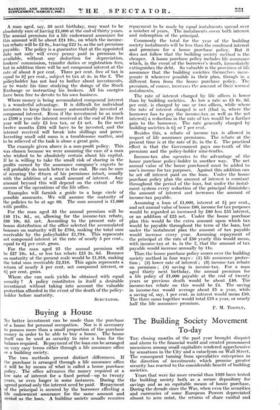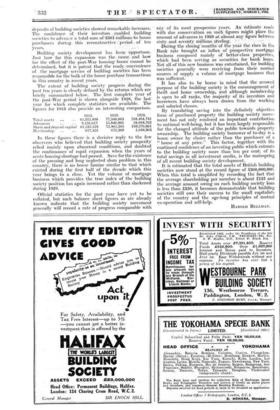The Building Society Movement To-day
THE closing months of the past year brought disquiet and alarm to the financial world and created pronounced uneasiness among small capitalists rendered apprehensive by sensations in the City and a cataclysm on Wall Street. The consequent turning from speculative enterprises in the direction of investments which promise greater security has reacted to, the considerable benefit of building societies.
Years that were far more crucial than 1929 have tested the building society both as - a secure depository for savings and as an equitable means of house purchase. During the decade since the War, when even the securities and'currencies of some European Powers depreciated' almost to zero point. the returns of share canital and deposits of building societies showed remarkable increases. The confidence of their investors , enabled building societies to advnEce a total sum of-£38finillions -ie: house purchasers during this reconstructive :A)eriOd ---rif ten years.
Building society development has been: 'opportune. Just how far this expansion was the. causej arid how far the 'effect of r the post-War housing -boom& Cannot be determined,. but it is patent that the ready: coniienience of the mortgage service of building societies- has been responsible for the bulk of the house purchaae transactions in this country in recent years. • The extent of building society progress during the past ten years is clearly defined by the rOililzig. which are briefly summarized below. The first cOniplete year of the post-War period is shown alongside 1928, the last year for which complete statistics are available. The figures for 1913 also provide an interesting comparison.
1913. 1919. 1928.
Total assets .. .. 65,315,898 77,346,603 268,464,781 Advances .. 9,131,017 15,840,961 58,668,762 Share and deposit capital 61,535,228 72,801,205 249,270,601 Membership .. • • 617,423 672,369 .1,688,903
In these figures there is a decisive reply to the few observers who believed that building society prosperity relied mainly upon abnormal conditions, and doubted the continuance of rapid expansion when the years of acute housing shortage had passed. Save for the existence of the pressing and long neglected slum problem in this country, there is no house famine similar to that which existed during the first half of the decade which this year brings to a close. Yet the volume of mortgage business which provides the true index of the building society position has again increased rather than slackened during 1929.
Official statistics for the past year have yet to be collated, but such balance sheet figures as are already known indicate that the building • society movement generally will record a rate of progress comparable with any Of its most prosperous years. An estimate made with due conservatism on such figures might place the amount of advances in 1929 at almost-any figure between sixty_ and severity Millions sterling. During the closinemonthi of The year the rises in the Bank rate brought an influx of prospective mortgage business composed mainly of • bettei-clasa properties, which had been serving as securities for bank loans. Not all of this new business was entertained, for building societies generally were receiving from their norrtial sources of supply a volume of mortgage business that was sufficient.
It has also to be borne in mind that the avowed purpose of the building society is the encouragement of thrift and home ownership, and although membership is open to all ranks, the majority of its investors and borrowers have always been drawn from the working and salaried classes.
By translating saving into the definitely objective form of purchased property the building- society move- ment has not only rendered an important contribution to national well-being, but it has been largely responsible for the changed attitude of the public towards property ownership. The building society borrower of to-day is a home owner by choice rather than the purchaser of a " house at any price." This factor, together with the continued confidence of an investing public which entrusts to the building society more than ten per cent. of its total savings in all investment media, is the mainspring of all recent building society development. It is estimated that the total assets of British building societies now stand at the record figure of £300,000,000. When this total is simplified by recording the fact that the average shareholding per member is about £125 and the average amount owing on each building society loan is less than £350, it becomes demonstrable that building societies still owe their success to the small capitalists of the country and the age-long principles of mutual co-operation and self-help.
HAROLD BELLMAN.

























































 Previous page
Previous page